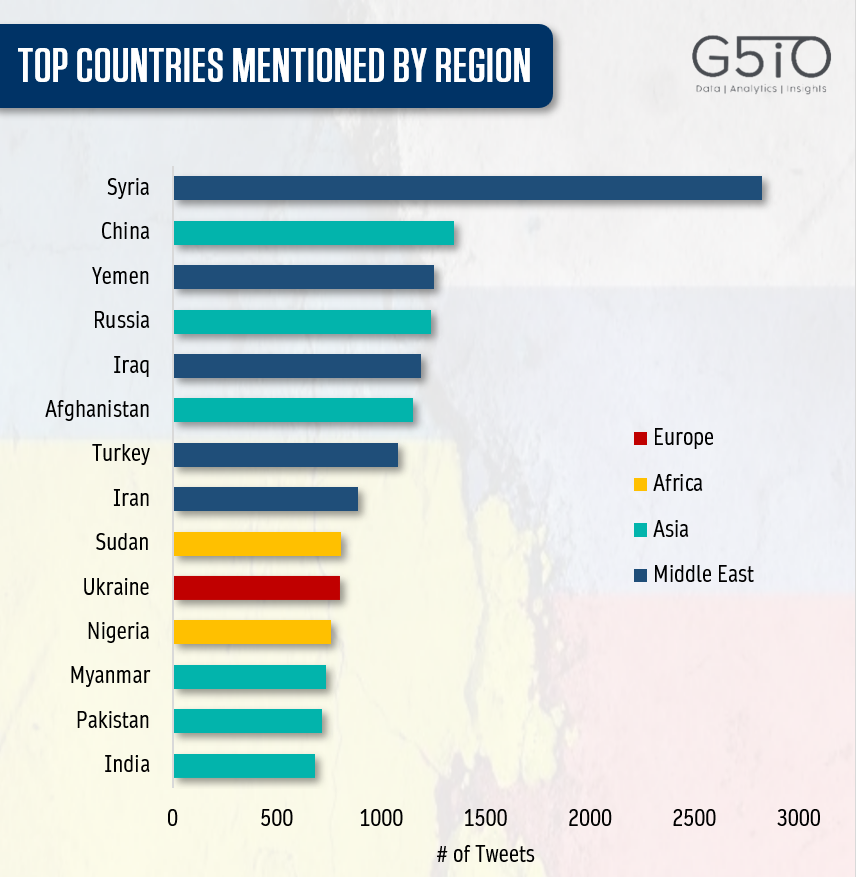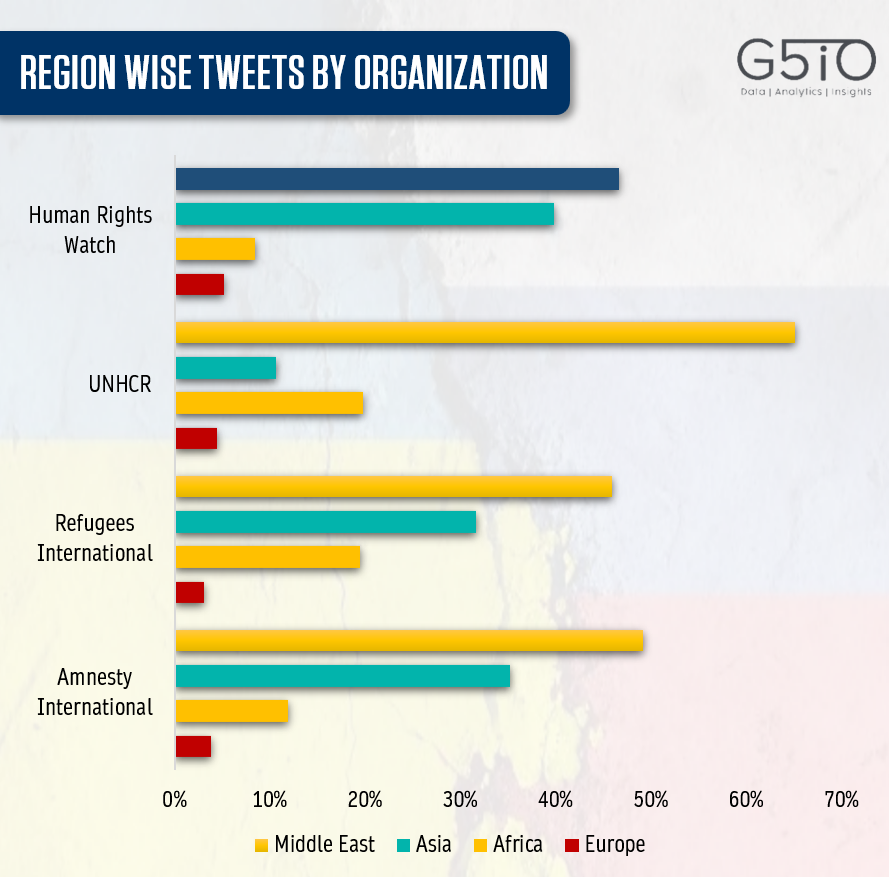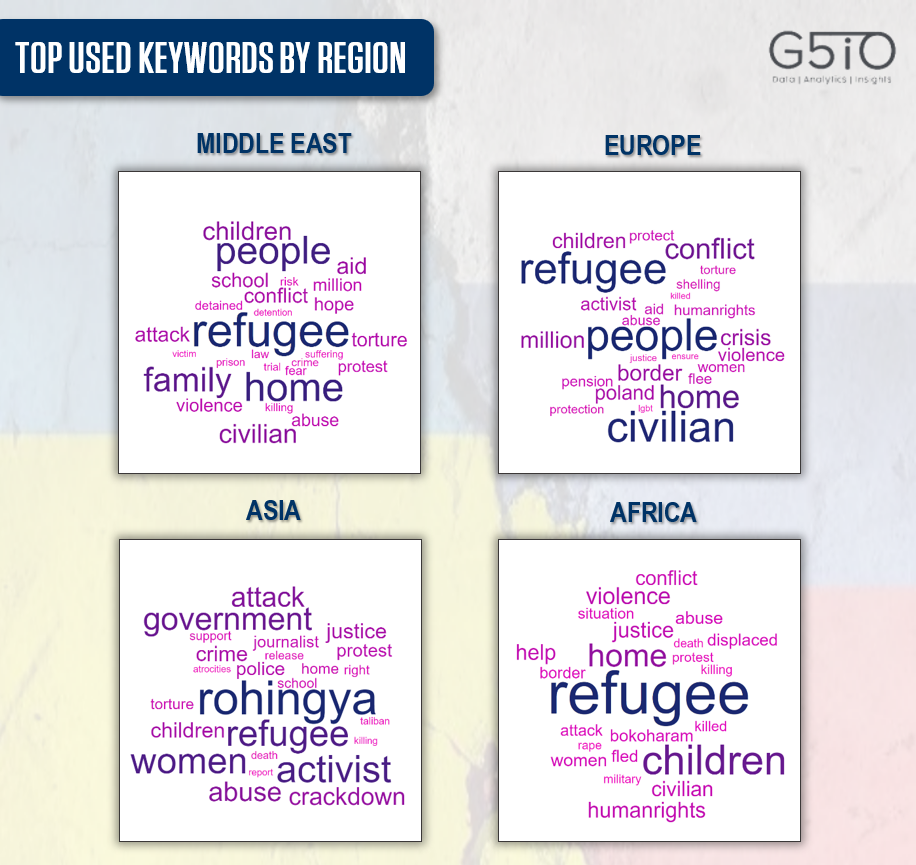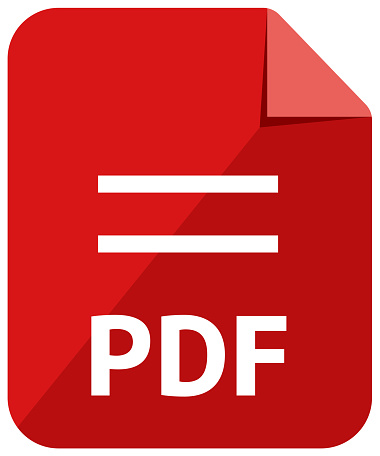Overview:
The ongoing Russia Ukraine conflict has resulted in a refugee crisis in Europe with more than 5 million Ukrainians displaced over the last two months. G5iO investigated Twitter timelines of some of the world’s most influential refugee watchdogs to evaluate not only the emphasis being given to the Ukrainian crisis, but also where it stands in relation to other major refugee crises across the world.
Methodology:
We scraped the Twitter timelines of four major international organizations working exclusively on relief work related to refugees. These comprised Amnesty International, UNHCR, Refugee International and Human Rights Watch containing a total of 136,800 tweets posted between January 2014 and April 2022.
Top Countries Mentioned:
Looking at which countries were mentioned the most by these organizations, we saw that the emphasis on Ukraine is almost at par with the focus being given to the crises in Sudan and Nigeria. This however still pales in comparison to the focus on the ongoing crises in the Middle East, specifically for instance in war torn Yemen and Iraq. Apart from these countries however, we also found that there was a global security nexus which was being politicized – especially in terms of how humanitarian issues related to these countries were being framed. For instance, after Syria, China was the most mentioned country; which can be considered disproportionate owing to the magnitude of the refugee crisis in several other countries. Also, while all the countries in the below graphs were referred to in relation to worsening humanitarian conditions, not all were mentioned specifically in the context of refugees. These include countries such as Russia, Turkey, India and Pakistan where the key concerns were human rights violations and freedom of speech.

Frequency of Tweets:
Plotting our data over the last 8 years, we saw that tweets related to the Middle-East refugee crisis dominated the last decade followed by Asia and Africa. However, as shown in the graph, the online discourse related to refugee crisis is going through a shift where the focus on the Middle-East is being replaced by Europe and Asia indicating a major shift in global politics and war locations. In 2022, the Ukrainian refugee crisis received the most attention even surpassing the Afghanistan and Rohingya refugee crises (Asia) which shows a shift towards a more Eurocentric refugee discourse.

Region-Wise Tweets:
All four organizations in our dataset talked about the Middle-Eastern refugee crisis more than others mainly because it is a persistent crisis spanning over a decade. However, it is worth mentioning that the Ukraine refugee crisis is gaining a notable mention in their tweets indicating a shift towards a European-centric discourse on refugees.

Narrative Through Word Clouds:
Perhaps the most interesting insight to have emerged from our dataset, however, is the different ways in which each region has been framed as part of the overall discourse on refugees. Based on a computer-generated text analysis of the most frequently used words in reference to the above-mentioned countries and regions, we see a marked difference in how refugees from Asia, Middle East & Africa are mentioned and portrayed in comparison to those from Europe.

For instance, while references to ‘home’, ‘conflict’ and ‘refugee(s)’ may appear as common across all regions, it’s the varying emphasis given to them that points to an inherent selective bias. This is evident in how the varying prominence of words like ‘home’, ‘people’ and ‘civilians’ when referring to European refugees stands in marked contrast to the greater emphasis being laid on ‘abuse’, torture and government (or lack thereof) when referring to countries in the Middle East, Asia and Africa. In Africa, the most effected countries by refugee crisis such as Sudan and Nigeria were mentioned in the context of terrorist activities such as ‘bokoharam’, ‘rape’, ‘women’ and children. Similarly, the discourse related to refugee crisis in Asia was also linked to ‘women’, ‘government’, ‘justice’, ‘crackdowns’ etc. In contrast, the refugee crisis in Europe was talked about in terms of ‘human rights’, ‘protection’, ‘aid’, ‘children’, ‘border’ which shows how the refugee crisis in Ukraine is seen through a more humanized and Eurocentric lens especially when compared to other global refugee crises.
Conclusion:
On the whole, the following insights were gleaned from our study:
- The Middle-Eastern refugee crisis has dominated the global refugee discourse in the last decade with a key focus on Syria.
- The global discourse on refugees has seen a marked shift towards Europe after the emergence of the Ukraine refugee crisis.
- The Ukrainian Refugee crisis has been given more attention than Afghanistan and other refugee crisis in 2022 especially in terms of how it has been framed and presented within overall global discourse.

